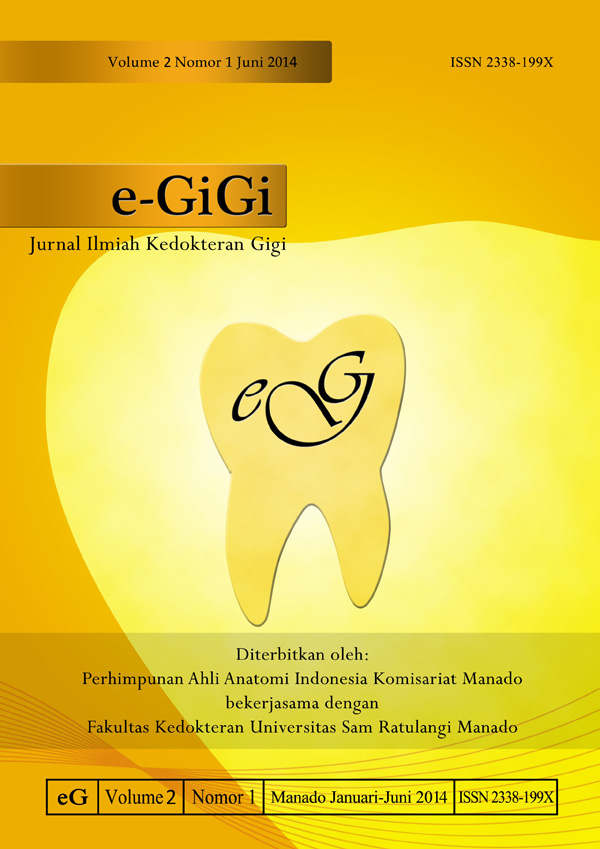PERUBAHAN KEKUATAN KOMPRESI DENTAL PLASTER YANG DICAMPUR DENGAN NACl DALAM BERBAGAI VARIASI KONSENTRASI
DOI:
https://doi.org/10.35790/eg.2.1.2014.4030Abstract
Abstract: Dental plaster is a type of sedimentary rock formed from limestone and chemically dissolved sulfate in the soil to form calcium sulfate (CaSO4 ). Dental plaster of the natural compound is generally a stable form of CaSO4 2H2O . Water contained in dental plaster water is not free but united by water molecules hence the nature of the universe is dental plaster is stable. If dental plaster hemihydrate reacts with water, the water molecules in the dental plaster back to the original amount. As a result of this reaction, the heat stored in dental plaster hemihydrate will be issued and the molecules of a separate dental plaster ( for burning ) reunite to form stable CaSO4 2H2O. This was an experimental study which aimed to test the compression strength of dental plaster mixed with NaCl in various concentrations. There were 3 samples to be tested. The results showed that at 0.5 % concentration of 7.06 MPa, at 1% 6.90 MPa, at 1.5% 12.23 MPa, at 2% 10.06 MPa, at 3 % 6.33 MPa, at 4% 4.42 MPa, and at control 8.63 MPa. At the concentration of 1.5 % as compared to the other concentrations, the use of electron - electron bound to each other from hemihydrate powder and the NaCl resulting in a stable chemical bonds that can increase the strengthness of compressed dental plaster mixed with 1.5 % NaCl.Conclusion: Dental plaster mixed with NaCl 4% had the lowest strengthness while dental plaster mixed with NaCl 1.5% had the highest strengthness.
Keywords: dental plaster, NaCl, compression tools
Abstrak: Dental plaster merupakan jenis batuan endapan yang terbentuk secara kimiawi dari kapur dan sulfat yang larut dalam tanah membentuk calcium sulfat (CaSO4), dental plaster yang dari alam umumnya merupakan senyawa stabil berbentuk CaSO4 2H2O. Air yang terkandung dalam dental plaster itu bukan berbentuk air bebas tetapi air yang bersatu dengan molekulnya sehingga dental plaster alam bersifat stabil. Bila dental plaster hemihidrat bereaksi dengan air maka molekul air di dalam dental plaster kembali ke jumlah semula. Akibat reaksi ini, panas yang tersimpan dalam dental plaster hemihidrat akan dikeluarkan dan molekul-molekul dental plaster yang terpisah (karena pembakaran) bersatu kembali ke bentuk stabil CaSO4 2H2O. Penelitian ini merupakan penelitian eksperimental yang bertujuan untuk menguji kekuatan kompresi dental plaster yang dicampur dengan NaCl dalam berbagai variasi konsentrasi. Terdapat 3 sampel untuk diuji. Hasil penelitian menunjukkan bahwa pada konsentrasi NaCl 0,5% kekuatan dental plaster 7,06 MPa; 1% 6,90 MPa; 1,5% 12,23 MPa; 2% 10,06 MPa; 3% 6,33 MPa; 4% 4,42 MPa; dan kontrol 8,63 MPa. Hasil pada konsentrasi 1,5% dibandingkan dengan kosentrasi lainya dikarenakan adanya pemakaian elektron-elektron yang saling terikat dari bubuk hemihidrat dan NaCl tersebut, sehingga terjadi ikatan-ikatan kimia stabil yang dapat menambah kekerasan atau kekuatan kompresi dari dental plaster tersebut saat dicampur dengan konsentrasi NaCl 1,5%.
Simpulan: Campuran dental plaster dengan NaCl 4% memiliki kekuatan terendah sedangkan dengan NaCl 1,5% memiliki kekuatan tertinggi.
Kata kunci: dental plaster, NaCl, alat kompresi
Downloads
How to Cite
Issue
Section
License
COPYRIGHT
Authors who publish with this journal agree to the following terms:
Authors hold their copyright and grant this journal the privilege of first publication, with the work simultaneously licensed under a Creative Commons Attribution License that permits others to impart the work with an acknowledgment of the work's origin and initial publication by this journal.
Authors can enter into separate or additional contractual arrangements for the non-exclusive distribution of the journal's published version of the work (for example, post it to an institutional repository or publish it in a book), with an acknowledgment of its underlying publication in this journal.
Authors are permitted and encouraged to post their work online (for example, in institutional repositories or on their website) as it can lead to productive exchanges, as well as earlier and greater citation of the published work (See The Effect of Open Access).






